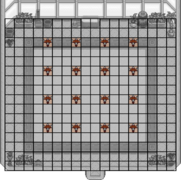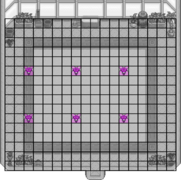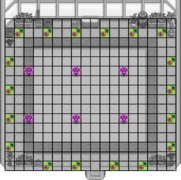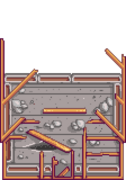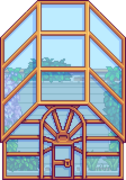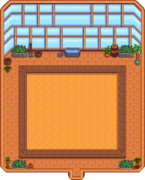Greenhouse
| Greenhouse | |
| A place to grow crops from any season, year round! | |
| Information | |
| Build cost: | All Pantry Bundles completed or |
| Build materials: | None |
| Size: | 7x6 |
The Greenhouse is a building present on the farm from the outset. However, it is initially in a state of disrepair, making it unusable. You can repair it by completing the Pantry bundles for the Community Center, or by a purchase from the Joja Community Development Projects for ![]() 35,000g.
35,000g.
Basics
The interior of the building features a 10-row-by-12-column plot of land. There, you can plant, grow, and harvest Crops at any time of year without reference to normal season restrictions. Scarecrows are not required in the greenhouse to prevent crows from eating crops. Crops do need to be watered, even on rainy days. There is a water trough along the north wall. Standing on its east side, you can refill your Watering Can. Fertilizer in the greenhouse lasts for one season only.
There is a wood border one tile thick surrounding the crop rectangle. It is possible to place sprinklers on this border to water any of the tiles of the crop land within its reach.
Between the wood border and the greenhouse walls is a region two tiles thick that is unsuitable for crops, and populated along the walls with decorative items (plants, tools, barrels, water trough). It is possible to plant fruit trees anywhere in this region, even on top of decorated tiles, so long as there are two tiles between fruit trees. Neither the greenhouse wall nor the wood border itself will impede the growth of the fruit trees, although a one-space separation must be maintained between the tree and any items (like sprinklers) that are placed on the wood border or exterior region during the time the tree is growing.
Crops and fruit trees in the greenhouse will never be hit by lightning.
Bee houses placed inside of the greenhouse produce no honey.
Optimizing Yields
Given that the greenhouse permits the production of most crops, regardless of season, its limited growing space is most valuable and should not be wasted. Crops that yield multiple harvests can be allowed to continue producing indefinitely without need for replanting, although fertilizer will expire.
Sprinkler Arrangement
If you intend to use automated sprinklers to water crops, some soil tiles must be sacrificed to place the sprinklers. The growing area is too large for any sprinkler to water the center from any edge. In addition, the 12-by-10 shape of the farmable area cannot be covered only with the square shapes of sprinkler watering.
The many possibilities yield various optimal sprinkler placements that cover the soil tiles while using the fewest possible sprinklers in plantable locations. Some sprinklers are inevitably placed on the wooden border. With iridium sprinklers, only 4 crop spaces (3.3%) must be taken, while with quality sprinklers, 12 crop spaces (10%) are occupied.
16 Quality Sprinklers. 12 crop spaces are occupied by sprinklers (-10%), leaving room for 108 plants.
6 Iridium Sprinklers. Only 4 crop spaces are taken by sprinklers (-3.3%), leaving room for 116 plants.
Fruit Tree Arrangement
Fruit trees can be grown in the tiled area outside of the wooden border that surrounds the soil. This tiled area is two tiles thick, consisting of an inner rectangle next to the wooden border, and an outer rectangle next to the Greenhouse wall. The outer rectangle includes the outermost corners, which are complete tiles even though the wall appears to slant through them. Unlike farmland tiles, neither the building edge nor the wooden border hinder the growth of fruit trees. Even the furniture items (like planters and barrels), purely decorative, do not crowd out the trees and stall their growth. In fact, fruit trees can be planted and grow right on top of a visual decoration (on the same tile), if so desired. (It is difficult to imagine why it would be desirable to plant a tree on top of the water trough, even though it would not hinder one from filling the water can.)
Therefore, the only considerations to be made when planting trees are their proximity to one another, and to any sprinklers that might be placed on the wood border. The trees will stall and refuse to grow if a sprinkler is occupying the 8-tile prohibited zone around the tree before it reaches maturity. As such, it may be necessary to temporarily move sprinklers for one season while the tree grows to its full size, or instead, to plant some of the trees in the outer rectangle, away from the sprinklers.
With this in mind, it is possible to grow as many as 18 fruit trees inside the greenhouse. One possible optimal configuration is displayed in the image that follows.
6 Iridium Sprinklers and 18 Fruit Trees placed to maximize planting space and trees.
Tip
You may notice that the given optimal configuration places one tree so that it blocks direct access to the right side of the watering can. One must go around the tree to get water. The image of the filled Greenhouse below, however, opens the access by placing only five trees in the north (top) row, reducing the total number of trees to 17. An alternative placement puts one tree in the outer rectangle, one tile away from the right side of the watering trough. Moving the next tree east one tile east, and the last tree into the corner, completes a reconfiguration that allows both easy access to the watering can and the maximum 18 trees in the Greenhouse, all without planting on top of any visual objects.
Gallery
- Greenhousefruit.jpg
Filled
History
- 1.0: Introduced.
- 1.07: Trees can no longer be planted on perimeter tiles around the soil area.
- 1.1: Trees can once again be planted on outside perimeter tiles.
| Buildings | ||
|---|---|---|
| Merchants | Abandoned House • Adventurer's Guild • Blacksmith • Bookseller • Carpenter's Shop • Casino • Desert Trader • Fish Shop • Giant Stump • Harvey's Clinic • Ice Cream Stand • Island Trader • JojaMart • Marnie's Ranch • Oasis • Pierre's General Store • Qi's Walnut Room • The Stardrop Saloon • Traveling Cart • Volcano Dwarf • Wizard's Tower | |
| Houses | 1 River Road • 2 River Road • 1 Willow Lane • 2 Willow Lane • 24 Mountain Road • Elliott's Cabin • Farmhouse • Island Farmhouse • Leah's Cottage • Mayor's Manor • Tent • Trailer • Treehouse | |
| Farm Buildings | Farming | Barn • Cabin • Coop • Fish Pond • Greenhouse • Mill • Pet Bowl • Shed • Silo • Slime Hutch • Stable • Well |
| Special | Desert Obelisk • Earth Obelisk • Farm Obelisk • Gold Clock • Island Obelisk • Junimo Hut • Water Obelisk | |
| Other Buildings | Community Center • Dog Pen • Island Field Office • Joja Warehouse • Movie Theater • Museum • Spa • Witch's Hut | |


